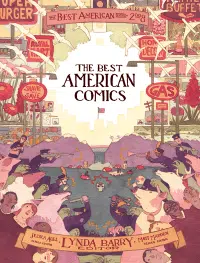
When the first Best American Comics was released in 2006, it seemed like a significant moment for legitimizing comics and graphic storytelling. Best American is a well respected brand, tied to annual anthologies in numerous genres and while recurrent comics anthologies weren’t new (MOME and Kramers Ergot had been in the game for years), a title that culled the best comics from the previous year, edited by a luminary in the field and published by a major book publisher, seemed to cement comics’ increasing evolution from back-room cult hobby to hip art medium and growing bookstore presence. In the same year as The Best American Comics 2006, Ivan Brunetti’s Anthology of Graphic Fiction, Cartoons, and True Stories was published. Brunetti unveiled a second volume in 2008 and the number of other comics anthologies has been on the rise. All this beg the question: now that comics and graphic storytelling have been widely accepted as a part of the arts, or at least as part of pop culture, what is the purpose of the comics anthology?
Comics anthologies, like anthologies in other genres, have limitations. There are only so many authors who can be included, and only so many pages from each contributor. This would then seem to favor comic artists who work on a short scale rather than those who produce book length works. Even though theBest American Comics line has included many passages from graphic novels or memoirs in its three volumes, the value of an excerpt of a book-length comic in such an anthology is a valid concern. These excerpts can feel more like a movie trailer than actual storytelling. The Best American Comics series has also seems to favor one-person “auteurs” who wrote personal indie or literary comics, rather than a team consisting of a writer and separate artist.
Fortunately, many of the limitations of the comics anthology are eclipsed by the sheer potency of the work carried within The Best American Comics 2008. The combination of Matt Madden and wife Jessica Abel as new series editors, along with Lynda Barry as guest editor proves to be a grouping that raises the Best American Comics series to another level. There feels a depth and diversity to these comics that surpasses what has come in the volumes before. The diversity is not just in artistic styles but also in tone. There are comics included in this volume that are realistic and topical as well as those that are fantastical; there are dark and somber stories as well as fun and clever ones; entries are narrative as well as introspective. The Best American Comics 2008 also moves into what’s sometimes snobbishly called “genre” comics in a way that previous volumes have not: there is a noir-ish story (Jason Lutes’ Berlin), a fascinating true crime tale (Rick Geary’s The Bloody Benders), and Barry had intended to include a Batman story (Paul Pope’s Batman Year 100) had DC Comics not withheld publishing rights.
If we return to the question of the purpose of the comic anthology today, the Best American Comics series would seem, by its name alone, to purport to be an authoritative voice on what’s going on in comics. This might lead one to ask if this book really gives its reader a representative sense of comics from the previous year? Well, yes and no. While The Best American Comics 2008 seems to be a good selection of what’s happening in comics these days, there is simply too much difference and idiosyncrasy amongst comic artists to successfully pin down a single trend for the previous year in comics. Perhaps the bombastic series title may suggest a canonical authority. However, by accepting that this is mostly a smart marketing move, aligning a new anthology with an established publishing brand, it becomes clearer that The Best American Comics 2008 may simply be a good book of good comics by good artists.
Madden and Abel sum up one of the best reasons for this anthology in their Preface when they write, “Anthologies are the place where young cartoonists get a break, where they can hope to be published alongside the likes of Chris Ware and Matt Groening, and to be noticed by the likes of Lynda Barry”. A danger the Best American Comics series could have run into was retreading the same mix of well-regarded comic creators over and over. However, Madden, Abel and Barry have done well in presenting a compelling mix of established names in comics and lesser-known artists. So while there are still selections from Ware, Groening, Alison Bechdel and Jaime Hernandez (all strong works, by the way), there is also exciting contributions from up-and-comers like John Mejias, Sarah Oleksyk, Joseph Lambert and Shawn Cheng.
Barry composes an illustrated Introduction to the volume, which seems to celebrate the joy of making comics, as well as the joy of reading them. The Best American Comics 2008 is a testament to this excitement for graphic storytelling. Readers may not like all of the stories here, but they all coalesce in a meaningful way that makes the book more than just a handful of comic strips designed as an honor roll. The comics anthology may not need to fight for respect any longer, but that doesn’t mean there still isn’t a need for comic anthologies as diverse, daring and enthusiastic as The Best American Comics 2008.
